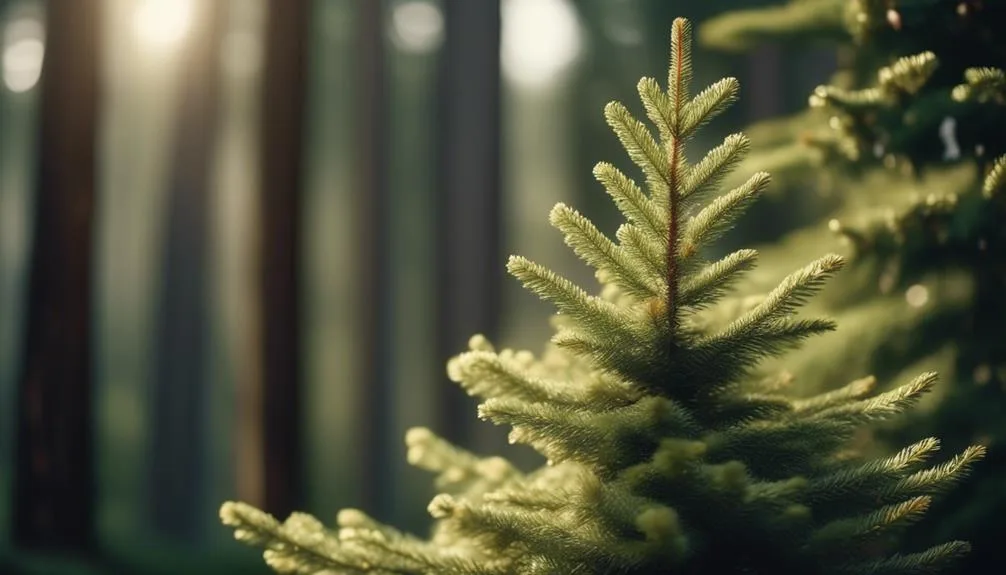Is your spruce tree refusing to grow? Don't worry, you're not alone. Many factors can cause stunted growth, from environmental conditions to pest problems.
But fear not, solutions abound. Stay tuned to discover the common culprits behind your spruce tree's lack of progress and learn how to give it the boost it needs to thrive.
Common Causes of Stunted Growth
If your spruce tree isn't growing as expected, there could be several common causes of stunted growth that you should consider.
Nutrient deficiencies are a frequent culprit, often caused by poor soil quality or an imbalance in essential elements such as nitrogen, phosphorus, or potassium. These deficiencies can hamper the tree's ability to grow and thrive.
Additionally, root issues, such as compacted soil, root rot, or damage from digging or construction, can also impede the tree's growth. It's essential to assess the root system for any signs of distress or constraint.
Addressing these issues promptly by providing the necessary nutrients and addressing root problems can help promote healthy growth and ensure your spruce tree thrives in the long run.
Assessing Environmental Conditions
When evaluating the environmental conditions affecting your spruce tree's growth, it's crucial to consider the impact of nutrient deficiencies and root issues on its overall health and development. Assessing soil moisture levels is essential, as spruce trees prefer well-drained, slightly acidic soils. Excessively wet or dry soil can hinder growth.
Understanding light and temperature requirements is equally important. Spruce trees thrive in full sunlight but can tolerate partial shade. In terms of temperature, they prefer cool to moderate climates and may struggle in excessively hot conditions.
Additionally, assessing the soil for nutrient deficiencies is vital. A lack of essential nutrients like nitrogen, phosphorus, and potassium can impede growth. Conducting a comprehensive assessment of these environmental factors will help you identify and address any issues hindering your spruce tree's growth.
Identifying and Treating Pest Infestations
To effectively protect your spruce tree from pest infestations, it is crucial to promptly identify any signs of pest presence and implement targeted treatment measures. Pests like aphids, spider mites, and spruce gall adelgids can cause significant harm to your tree if left unaddressed. Here are some treatment options to consider:
| Pest | Signs of Infestation | Treatment Options |
|---|---|---|
| Aphids | Curling leaves, sticky residue on branches | Insecticidal soap, neem oil |
| Spider Mites | Fine webbing on needles, yellow stippling | Horticultural oil, predatory mites |
| Spruce Gall Adelgids | Swollen, abnormal growth on needles | Pruning, insecticidal soap |
Regularly inspecting your spruce tree for these signs and promptly applying the appropriate treatment can help ensure its health and growth. Remember to follow manufacturer instructions when using any pest control products.
Implementing Proper Care and Maintenance
Proper care and maintenance are essential for ensuring the health and vitality of your spruce tree throughout its growth. When it comes to pruning techniques, it's crucial to remove any dead, damaged, or diseased branches to promote healthy growth. Prune during the dormant season, and avoid cutting off more than a third of the tree's total branches.
Additionally, regularly inspect the tree for any signs of pests or diseases and promptly address any issues that arise. Soil nutrition is another key aspect of care. Ensure the soil around your spruce tree is well-draining and rich in organic matter. Consider using a balanced fertilizer specifically formulated for evergreen trees to provide essential nutrients.
Seeking Professional Guidance
For expert advice on addressing specific issues or concerns with your spruce tree, consulting a certified arborist is a wise decision. A professional arborist can provide valuable insights and recommendations tailored to your tree's unique needs. When seeking professional guidance, consider the following:
- Tree pruning: An arborist can assess the current state of your spruce tree and determine if pruning is necessary to promote healthy growth and structural integrity.
- Soil testing: By analyzing the soil around your spruce tree, an arborist can identify any deficiencies or imbalances that may be hindering its growth. They can then recommend appropriate soil amendments to optimize conditions for the tree.
Professional guidance from a certified arborist ensures that you receive expert assistance in addressing any concerns with your spruce tree, ultimately contributing to its overall health and vitality.
Conclusion
In nurturing your spruce tree, addressing environmental factors, managing pest infestations, and providing proper care are essential.
Seeking professional guidance if needed ensures the tree's resilience.
With thoughtful attention, your spruce tree can overcome challenges and flourish.

My interest in trees started when I first saw the giant sequoias in Yosemite.
I was a teenager then, and I remember thinking, “I need to learn more about this.”
That moment stuck with me.
A few years later, I went on to study forestry at Michigan Tech.
Since graduating, I’ve worked in a mix of hands-on tree care and community education.
I’ve spent over ten years helping people understand how to plant, maintain, and protect the trees in their neighborhoods.
I don’t see trees as just part of the landscape.
They are living things that make a real difference in our daily lives.
